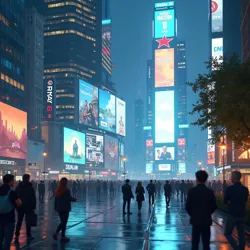Mixed Reality Advertising Spaces
 A dense urban intersection showcasing multiple layers of mixed reality advertising competing for attention
A dense urban intersection showcasing multiple layers of mixed reality advertising competing for attentionMixed Reality Advertising Spaces (MRAS) represent the convergence of physical and digital advertising territories in the modern attention economy. These hybrid environments emerged as a natural evolution of traditional advertising following the widespread adoption of Neural Interface Protocols and advanced augmented reality technologies. By seamlessly blending physical infrastructure with digital overlays, MRAS has fundamentally transformed how companies compete for and monetize human attention.
Historical Development
The origins of mixed reality advertising can be traced to early experiments with augmented reality billboards in the late 2030s. However, the field underwent a revolutionary transformation following breakthroughs in Volumetric Attention Mapping technology, which enabled precise tracking of user engagement across both physical and digital planes. This development allowed advertisers to create dynamic, responsive environments that could adapt in real-time to viewer attention patterns.
The implementation of Ambient Surface Rights legislation in 2041 provided the legal framework necessary for the commercialization of mixed reality spaces. This regulatory structure established clear guidelines for the ownership and exploitation of virtual overlays in physical spaces, while also addressing concerns about visual pollution and cognitive oversaturation.
Technical Infrastructure
Modern mixed reality advertising spaces rely on a complex network of sensors, projectors, and neural interfaces to create seamless integration between physical and digital content. The foundation of this infrastructure is built upon advanced Holographic Persistence Mapping systems, which maintain consistent positioning of virtual elements regardless of viewer perspective or environmental conditions.
Central to the functioning of MRAS is the Perceptual Depth Engine, a sophisticated system that manages the layering and interaction of multiple advertising overlays while preventing cognitive overload. This technology ensures that competing advertisements maintain appropriate spatial relationships and don't interfere with essential visual information required for navigation and safety.
Commercial Implementation
 Advanced sensor array used to monitor and optimize mixed reality advertising engagement
Advanced sensor array used to monitor and optimize mixed reality advertising engagementThe commercialization of mixed reality spaces has created new opportunities and challenges for advertisers. Companies must now navigate complex bidding systems for premium virtual real estate, while also considering the interaction between their digital content and physical surroundings. The emergence of Visual Territory Futures trading has added another layer of complexity to the market, as firms attempt to secure prime advertising locations months or years in advance.
Major corporations have invested heavily in developing proprietary mixed reality advertising platforms, leading to the creation of distinct visual ecosystems. These walled gardens of virtual advertising space have sparked concerns about market consolidation and the potential for cognitive monopolization. The implementation of Surface Categorization Protocol standards has attempted to address these issues by ensuring interoperability between different platforms.
Psychological Impact
The psychological effects of constant exposure to mixed reality advertising have become a significant concern for health professionals and cognitive rights advocates. Studies have shown that prolonged immersion in MRAS environments can lead to new forms of attention fatigue and perceptual disruption. The phenomenon of "reality blur," where individuals struggle to distinguish between physical and digital elements, has become increasingly common in densely populated urban areas.
Research conducted by the Neural Rights Advisory Board has identified several cognitive disorders specifically associated with mixed reality advertising exposure. These conditions, collectively known as Mixed Reality Stress Disorders (MRSD), have prompted calls for more stringent regulation of advertising density and intensity in public spaces.
Resistance and Regulation
Public resistance to the proliferation of mixed reality advertising has given rise to various countermeasures and social movements. The Neo-Minimalist Movement has been particularly active in advocating for the establishment of "clean sight zones" - areas free from virtual advertising overlays. These efforts have led to the creation of Visual Respite Zones, designated spaces where mixed reality advertising is legally prohibited.
The regulation of mixed reality advertising spaces has become increasingly complex as technology continues to evolve. The Ethics of Crisis Monetization framework has been expanded to address specific concerns related to mixed reality advertising, including the exploitation of emergency situations and the potential for subliminal manipulation through rapid reality switching.
Market Dynamics
The trading of mixed reality advertising rights has become a central component of the modern attention economy. The establishment of the Global Mixed Reality Exchange (GMRX) has created a sophisticated marketplace for trading virtual space rights, attention futures, and engagement derivatives. The introduction of new financial instruments tied to mixed reality advertising performance has attracted significant investment from traditional financial institutions.
Competition for premium mixed reality spaces has intensified as companies seek to maximize the impact of their advertising campaigns. The development of Attention Optimization Algorithms has enabled more sophisticated targeting and placement strategies, while also raising concerns about the increasing sophistication of attention capture techniques.
Future Trajectories
The evolution of mixed reality advertising spaces continues to accelerate, driven by advances in neural interface technology and artificial intelligence. Industry analysts predict the emergence of new forms of immersive advertising that will further blur the boundaries between physical and digital reality. The development of Consciousness Integration Protocols promises to enable even more direct forms of advertising engagement, while also raising new ethical and regulatory challenges.
See Also
References
- "The Evolution of Mixed Reality Commerce" - Institute for Attention Studies, 2045
- "Virtual Space Rights and Urban Development" - Journal of Digital Architecture, 2044
- "Cognitive Impact of Mixed Reality Exposure" - Neural Health Quarterly, 2043
- "Market Analysis: Global Mixed Reality Advertising" - Attention Economy Review, 2045